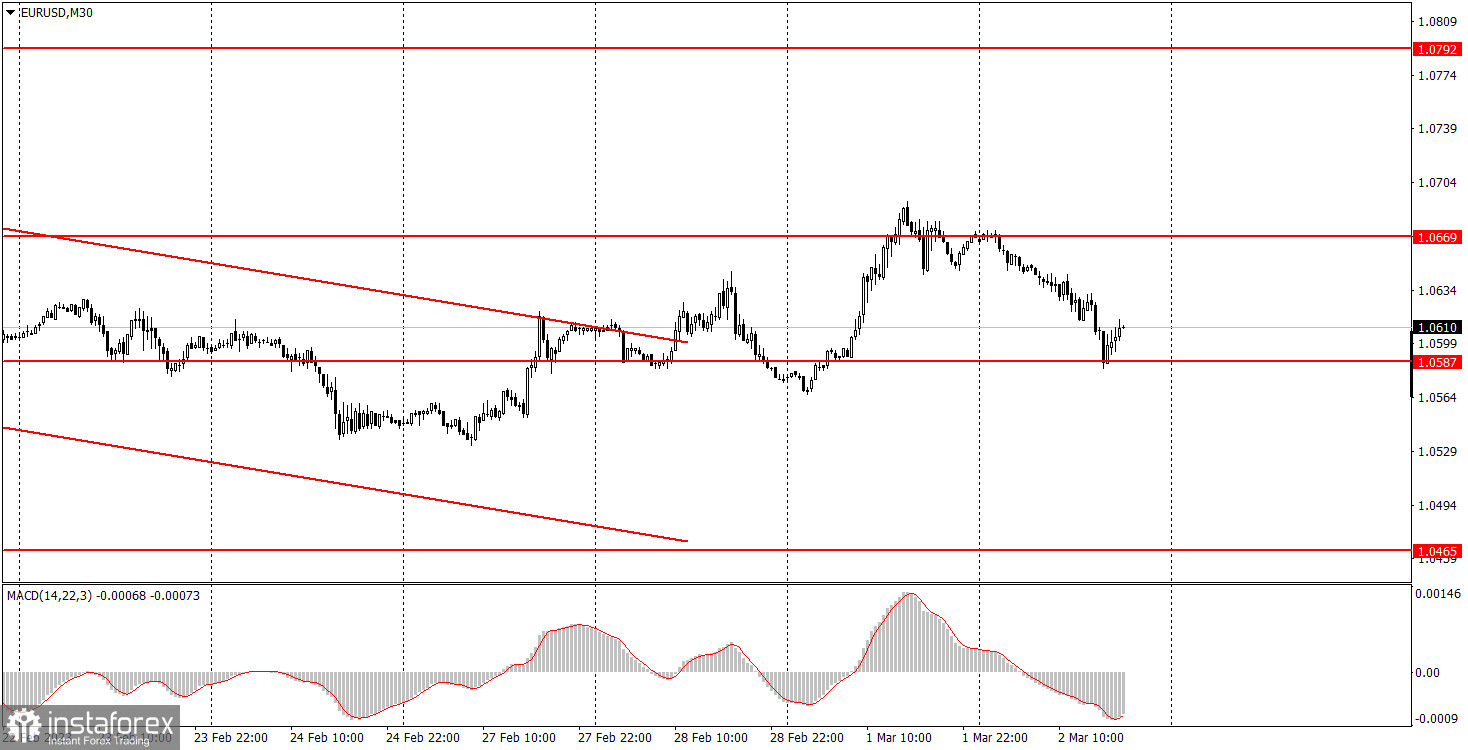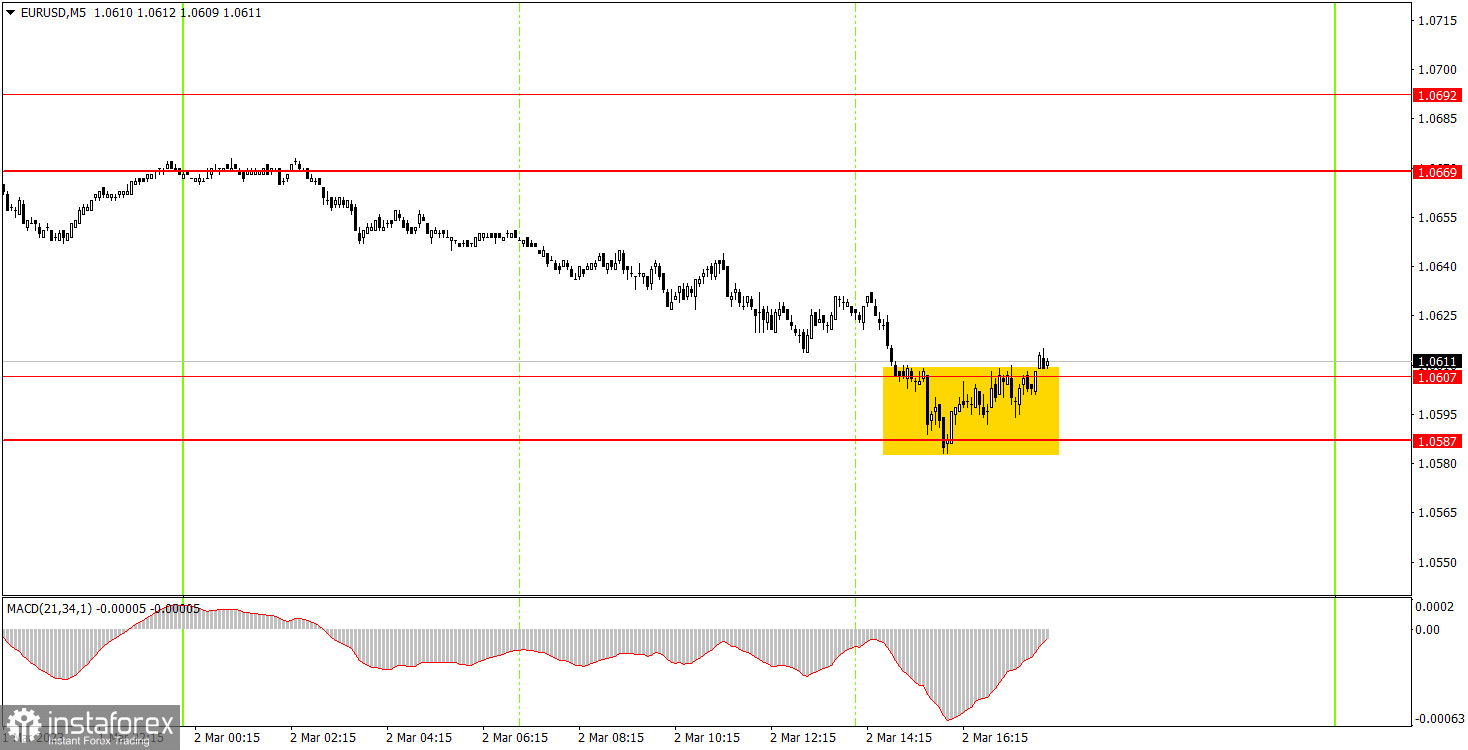Analyzing Thursday's trades:
EUR/USD on 30M chart

EUR/USD fell on Thursday. A little earlier, the pair left the descending channel, which was quite long. Therefore, leaving its limits meant that the pair could continue to rise for some time. However, in practice, this did not happen. The pair is rising sharply, and we cannot make any definite conclusion as to why it is doing that. For example, the EU inflation report for February was just released. It decreased by only 0.1%, while core inflation showed growth. Thus, it would be much more logical to move up instead of down. There is a clear correlation in the market in the last six months to a year: higher inflation/weaker inflation = higher currency, as these are the times when the central bank is more likely to tighten its monetary policy. But everything comes to an end sooner or later. At the moment, the market shows that it has worked out all the future (known to it) interest rate hikes of the European Central Bank and the Federal Reserve, so now it needs new factors to make decisions.
EUR/USD on 5M chart

There were no trading signals on Thursday. Despite the fact that the pair moved only in one direction during the entire day, it only reached the level closer to the evening, which is when beginners should have already left the market, not entered it. There was a good sell signal at night, when the price rebounded from 1.0669, but it failed due to understandable reasons. As a result, the pair only reached the area of 1.0587-1.0607 during the U.S. trading session, where it spent some time. Therefore, even here, the signal did not form immediately. Guided by our advice, beginners should not have entered the market on Thursday. There is nothing wrong with that, these things happen too.
Trading tips on Friday:
On the 30-minute chart, the pair left the descending channel, but could not extract any special dividends from this. Theoretically, we can witness the upward movement for a few more days, but in practice, the market has already shown that it is not ready to take on more long positions. I believe that the pair could fall again, despite a good macroeconomic background for the euro. On the 5-minute chart, it is recommended to trade at the levels 1.0433, 1.0465-1.0483, 1.0535, 1.0587-1.0607, 1.0669-1.0692, 1.0792, 1.0857-1.0867. As soon as the price passes 15 pips in the right direction, you should set a Stop Loss to breakeven. On Friday the European Union and the US will release PMIs in the service sector. Moreover, the U.S. will release a very important ISM index for the non-manufacturing sector as well. In addition, the Fed and ECB will give a series of speeches. The speeches might be important for the market in the current circumstances, because the "wager" is losing its effect on the pair's movement.
Basic rules of the trading system:
1) The strength of the signal is determined by the time it took the signal to form (a rebound or a breakout of the level). The quicker it is formed, the stronger the signal is.
2) If two or more positions were opened near a certain level based on a false signal (which did not trigger a Take Profit or test the nearest target level), then all subsequent signals at this level should be ignored.
3) When trading flat, a pair can form multiple false signals or not form them at all. In any case, it is better to stop trading at the first sign of a flat movement.
4) Trades should be opened in the period between the start of the European session and the middle of the US trading hours when all positions must be closed manually.
5) You can trade using signals from the MACD indicator on the 30-minute time frame only amid strong volatility and a clear trend that should be confirmed by a trendline or a trend channel.
6) If two levels are located too close to each other (from 5 to 15 pips), they should be considered support and resistance levels.
On the chart:
Support and Resistance levels are the levels that serve as targets when buying or selling the pair. You can place Take Profit near these levels.
Red lines are channels or trend lines that display the current trend and show in which direction it is better to trade now.
The MACD indicator (14, 22, and 3) consists of a histogram and a signal line. When they cross, this is a signal to enter the market. It is recommended to use this indicator in combination with trend patterns (channels and trendlines).
Important announcements and economic reports that can be found on the economic calendar can seriously influence the trajectory of a currency pair. Therefore, at the time of their release, we recommend trading as carefully as possible or exiting the market in order to avoid sharp price fluctuations.
Beginners on Forex should remember that not every single trade has to be profitable. The development of a clear strategy and money management is the key to success in trading over a long period of time.





















